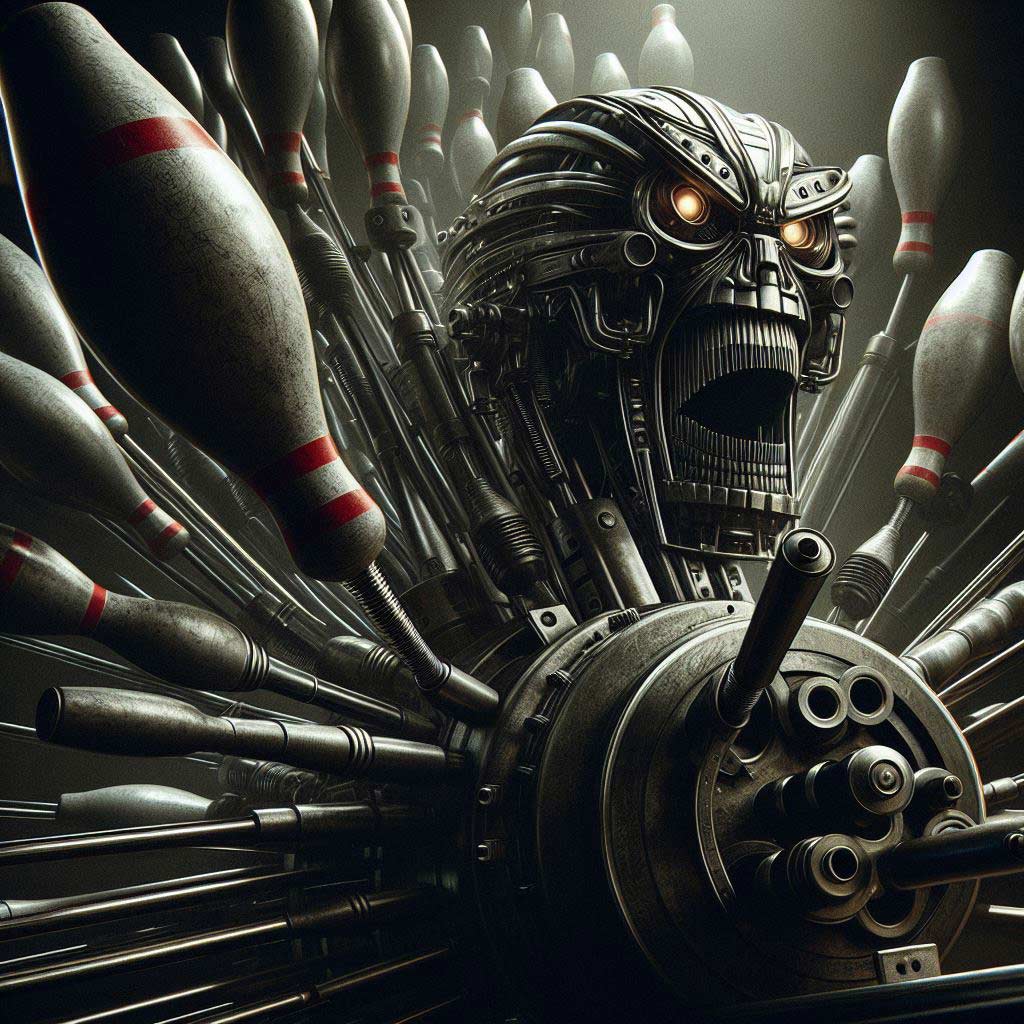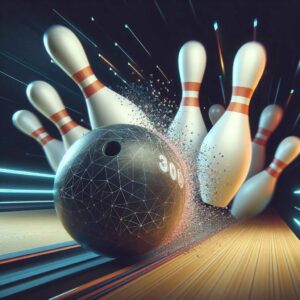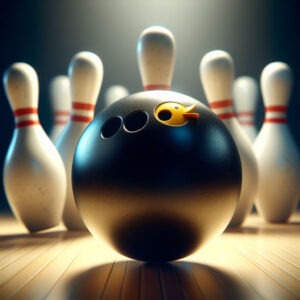Bowling is a beloved sport enjoyed by millions worldwide, often considered a safe and family-friendly activity. However, a tragic incident in 2022 served as a grim reminder of the potential dangers lurking behind the scenes.
A 28-year-old man at a bowling alley in Gastonia, North Carolina, lost his life after being struck by a pinsetter machine while attempting to retrieve a stuck bowling ball.
This horrifying accident highlights the serious risks associated with bowling pinsetters that every bowler should be aware of. While bowling itself is generally safe, the powerful machinery responsible for resetting the pins after each frame poses some grave hazards if not treated with caution and respect.
In this comprehensive guide, we’ll explore the dangers of bowling pinsetters, examining fatalities and injuries caused by these machines, common causes of accidents, safety precautions, and regulations, and the future of pinsetter safety. By understanding the risks and following proper protocols, bowlers can enjoy the sport while minimizing their exposure to potential harm.
What are Bowling Pinsetters?
Bowling pinsetters, also known as pin spotters or pin setters, are computerized machines responsible for efficiently clearing fallen pins from the bowling lane and resetting them for the next frame.
These complex machines are essential for the smooth operation of modern bowling alleys, allowing games to flow seamlessly without the need for manual pin resetting.
Pinsetters operate with remarkable speed and power, using a combination of sweeping arms, belts, and lifters to swiftly clear the fallen pins and position new ones precisely on the deck.
While their efficiency is impressive, the moving parts and sheer force of these machines make them inherently dangerous if not handled properly.
Fatalities and Injuries Caused by Pinsetters
The potential hazards of bowling pinsetters are not mere speculation – there have been numerous incidents over the years resulting in severe injuries and even fatalities.
According to data from the Bowling Proprietors’ Association of America (BPAA), between 2010 and 2019, there were 12 reported deaths and countless injuries directly attributed to pinsetter accidents in bowling alleys across the United States.
One of the most shocking incidents occurred in 2012 when a 28-year-old man in Massachusetts was killed after being struck in the head by a pinsetter machine while attempting to retrieve a stuck bowling ball.
In another tragic case in 2016, a 6-year-old boy in Florida lost his life after becoming trapped in a pinsetter’s moving parts while trying to retrieve a plastic tube he had dropped on the lane.
These heartbreaking stories serve as sobering reminders of the grave consequences that can result from improper interaction with pinsetter equipment.
Common Causes of Pinsetter Accidents
Understanding the common causes of pinsetter accidents is crucial for preventing future incidents. Some of the most prevalent factors contributing to injuries and fatalities include:
- Reaching into the Pinsetter Area: One of the most common and dangerous mistakes bowlers make is reaching into the pinsetter area to retrieve a stuck ball or other item. The pinsetter’s moving parts operate at high speeds and with immense force, making it extremely hazardous for anyone to reach into the machine’s path.
- Getting Too Close During Maintenance or Repairs: Bowling alley staff and technicians who perform maintenance or repairs on pinsetter machines are also at risk if proper safety protocols are not followed. Failing to fully deactivate and lock out the machine’s power before working on it can lead to catastrophic accidents.
- Mechanical Failures or Malfunctions: While rare, there have been instances where mechanical failures or programming errors have caused pinsetter machines to malfunction, potentially putting nearby individuals in harm’s way. Regular maintenance and timely repairs are crucial to minimize these risks.
- Lack of Safety Protocols or Human Error: In some cases, accidents occur due to a lack of clearly established safety protocols or human error in following existing guidelines. Proper training and consistent adherence to best practices are essential for mitigating risks associated with pinsetters.
Safety Precautions and Regulations
To address the dangers posed by bowling pinsetters, various safety precautions and regulations have been put in place by bowling associations, equipment manufacturers, and individual bowling centers. Some of the key guidelines and best practices include:
- Bowler Safety Guidelines:
- Never attempt to retrieve a stuck ball or any item from the pinsetter area. Always wait for the machine cycle to complete before stepping onto the lane.
- Do not lean over or put any part of your body in the pinsetter’s path.
- Follow all posted warnings and instructions from bowling alley staff.
- Ensure children are properly supervised and educated about the risks of interacting with pinsetter equipment.
- Staff Safety Protocols:
- Implement strict lockout/tagout procedures to ensure pinsetter machines are fully deactivated and isolated from power sources before performing any maintenance or repairs.
- Provide comprehensive training to staff on proper pinsetter operation, safety protocols, and emergency procedures.
- Conduct regular safety inspections and audits to identify and address potential hazards.
- Equipment Regulations and Standards:
- Manufacturers of pinsetter machines must comply with stringent safety standards and regulations set by organizations like the American National Standards Institute (ANSI) and the BPAA.
- Guidelines cover aspects such as machine guarding, emergency stop mechanisms, and operator safety devices to minimize risks.
- Bowling Center Responsibilities:
- Prominently display warning signs and safety instructions near pinsetter areas.
- Implement strict policies prohibiting bowlers from attempting to retrieve items from the pinsetter area or performing any unauthorized interactions with the machines.
- Conduct regular maintenance and inspections of pinsetter equipment to ensure proper functioning and identify potential issues.
- Establish clear emergency protocols and procedures in case of an accident or incident involving a pinsetter.
By adhering to these safety precautions and regulations, bowling centers can significantly reduce the likelihood of pinsetter-related accidents and create a safer environment for bowlers and staff alike.
The Future of Pinsetter Safety
As technology continues to evolve, there are opportunities to further enhance the safety of bowling pinsetters through innovative design and engineering solutions. Some potential advancements and areas of focus include:
- Advanced Sensor and Detection Systems: Incorporating more sophisticated sensor arrays and object detection systems into pinsetter machines could help identify potential hazards or obstructions in the machine’s path, triggering automatic shutdowns or alerts to prevent accidents.
- Improved Guarding and Shielding: While current pinsetter models have physical guards and barriers in place, advancements in materials and design could lead to more robust and effective shielding mechanisms that better protect individuals from the moving parts of the machines.
- Enhanced Fail-Safe Mechanisms: Developing more robust fail-safe systems that automatically shut down pinsetter operations in the event of a malfunction or unexpected behavior could significantly reduce the risk of accidents caused by mechanical failures or programming errors.
- Increased Safety Automation: Exploring ways to automate more safety processes, such as automatically deactivating pinsetter power when a lane is cleared or implementing intelligent monitoring systems that detect potential hazards, could help minimize human error and oversight.
- Prioritizing Staff Training and Certification: Continuing to emphasize comprehensive training and certification programs for bowling alley staff who interact with or maintain pinsetter equipment is crucial. Ensuring all personnel are well-versed in the latest safety protocols and best practices will be an ongoing priority.
- Collaboration and Knowledge Sharing: Fostering collaboration between bowling associations, equipment manufacturers, and bowling centers to share knowledge, insights, and best practices related to pinsetter safety can drive continuous improvement and help standardize guidelines across the industry.
By embracing technological advancements, emphasizing training, and cultivating a culture of safety, the bowling industry has the potential to significantly reduce the risks associated with pinsetter machines and create an even safer environment for bowlers and staff.
Conclusion:
Bowling is a beloved pastime that brings joy and entertainment to millions, but the potential dangers posed by powerful pinsetter machines cannot be ignored. While fatalities and severe injuries from pinsetter accidents are relatively rare, the consequences of such incidents can be catastrophic.
By understanding the common causes of accidents, adhering to established safety precautions and regulations, and embracing future advancements in pinsetter technology and training, the bowling community can work together to minimize risks and create a safer environment for everyone involved.
Remember, as a bowler, it is essential to exercise caution and follow all safety guidelines when in the presence of pinsetter machines. Never attempt to retrieve items from the pinsetter area, and always respect the power and potential hazards of these complex machines.
Bowling alley operators and staff must also remain vigilant in their commitment to safety protocols, maintenance schedules, and comprehensive training programs.
By prioritizing safety and working collaboratively to implement best practices, the bowling industry can continue to provide an enjoyable and secure experience for enthusiasts of all ages.
Stay safe, follow the rules, and spread awareness about the importance of pinsetter safety. Together, we can ensure that this beloved sport remains a cherished pastime for generations to come, without the looming threat of preventable accidents or tragedies.
Frequently Asked Questions
Why was 9-pin bowling illegal?
Nine-pin bowling was once banned in some areas due to its association with gambling and criminal activities. In the early 19th century, particularly in parts of the United States and Canada, nine-pin bowling alleys were often connected to underground gambling dens and organized crime. As a result, many jurisdictions outlawed the game in an attempt to curb these unlawful activities. The ban led to the creation of ten-pin bowling, which became a more widely accepted and legal alternative.
What happens if a bowling ball hits your head?
If a bowling ball, weighing between 6 and 16 pounds, were to strike someone in the head, the consequences could be catastrophic. The force and weight of a bowling ball traveling at high speeds could cause severe head trauma, including skull fractures, brain hemorrhages, and potentially fatal injuries. Even a glancing blow could result in concussions, loss of consciousness, and long-lasting cognitive impairment. Immediate medical attention would be critical in such a situation to address potential brain injuries and internal bleeding.
Do bowling pins ever break?
Yes, bowling pins can and do break during play, although modern pins are designed to be quite durable. Pins are typically made from high-quality wood, such as maple, and can withstand significant impacts. However, when struck at certain angles or with extreme force, the pins can crack, split, or even shatter into multiple pieces. Over time, the repeated stress and impacts can also cause pins to develop cracks or chips. Most bowling alleys have protocols in place to regularly inspect and replace any damaged or broken pins to ensure a safe and consistent playing experience.
How many pins can you hit in bowling?
In a standard game of ten-pin bowling, the maximum number of pins that can be hit with a single roll is ten. This is achieved when all ten pins are cleanly knocked down in a “strike.” However, there are also scenarios where more than ten pins can be affected in a single frame. If a bowler rolls a strike and carries over pins from the previous frame, they can potentially knock down more than ten pins in that frame. Additionally, in certain specialized bowling games or tournaments, there may be setups with more than ten pins, allowing for higher potential pin counts per roll.
Is there a 10-pin bowling?
Yes, ten-pin bowling is the most widely recognized and played form of bowling worldwide. In ten-pin bowling, there are ten pins set up in a triangular formation at the opposite end of a long, narrow lane. The objective is to knock down all ten pins with a single roll of the bowling ball. Ten-pin bowling is played in bowling alleys across the globe and is the form of bowling used in professional tournaments, including the Professional Bowlers Association (PBA) events.
What game has 100-pin bowling?
The game you’re referring to is likely “Bowlingo,” which involves a setup of 100 pins on the bowling lane. Bowlingo is a variation of traditional bowling that originated in the United States in the late 1990s. In Bowlingo, the pins are arranged in a grid or pattern, often with different colors or shapes, creating a visually striking display of 100 pins. Players attempt to knock down as many pins as possible with a single roll, aiming for high scores and patterns. Bowlingo is played more for entertainment and novelty purposes rather than as a competitive sport.
What happens if you hit your head 3 times?
Sustaining multiple head injuries, even if they seem minor, can have serious cumulative effects and increase the risk of long-term complications. Each time the head is impacted, it can cause the brain to move within the skull, potentially leading to bruising, swelling, and damage to brain tissue. Repeated head injuries, even without loss of consciousness, can result in conditions such as chronic traumatic encephalopathy (CTE), which can cause cognitive impairment, emotional disturbances, and neurological problems over time.
If someone experiences three or more head injuries within a relatively short period, it’s crucial to seek medical attention. Health professionals can evaluate the severity of the impacts, monitor for signs of concussion or brain injury, and provide appropriate treatment and guidance to prevent further harm.
Can you hit your head and not remember it?
Yes, it is possible to sustain a head injury and not have any immediate memory of the incident. This is known as traumatic amnesia or post-traumatic amnesia (PTA). In some cases of head trauma, particularly concussions or more severe brain injuries, the individual may experience a period of confusion, disorientation, and memory loss surrounding the event itself.
The brain’s ability to form and store new memories can be temporarily impaired after a head injury, leading to gaps in recollection. The duration of the amnesia can vary from a few minutes to several hours or even days, depending on the severity of the impact and the extent of brain trauma.
If someone has hit their head and cannot recall the incident or the events leading up to it, it is essential to seek medical evaluation as soon as possible. Amnesia can be a sign of a potentially serious brain injury that requires prompt attention and treatment.
Can your body hurt from bowling?
Yes, it is possible to experience body pain or injuries from bowling, particularly if proper form and technique are not used. Some common areas of discomfort or injury associated with bowling include:
- Wrist pain: Improper wrist position or excessive twisting during the bowling swing can lead to wrist strains or tendonitis.
- Elbow pain: Overuse or incorrect arm motion can cause elbow tendinitis or irritation of the ulnar nerve (often referred to as “bowler’s elbow”).
- Shoulder pain: Repetitive overhead motions and improper arm swing can result in shoulder impingement or rotator cuff issues.
- Back pain: Poor posture, improper lifting of the bowling ball, or excessive twisting of the trunk during the swing can lead to lower back strains or disc problems.
- Knee pain: The sliding motion during the bowling approach and the impact of the delivery can put stress on the knees, potentially causing issues like patellar tendonitis or meniscus injuries.
To minimize the risk of injury, it’s essential for bowlers to maintain proper form, warm up adequately, use appropriate-weight bowling balls, and consider using wrist braces or other supportive equipment when needed. Moderation, stretching, and strengthening exercises can also help prevent bowling-related body pains and injuries.





